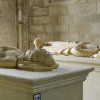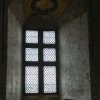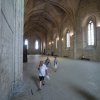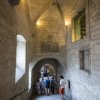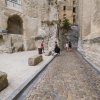Does unlimited power and wealth make up for celibacy? It does if you are the Pope. No wonder they are so old when elected, that way the abstinence does not interfere with their vows and duties. Give me another 20 years and I’d be happy to enjoy a similar lifestyle, provided it comes with sacks of wealth and treasure, unchecked power and a pointy hat. Such was the history we witnessed whilst exploring the old Papal Palace in Avignon.
Before serving up the photos, the following excerpts from wikipedia will shed some light on this historic building.
Often referred to as the “City of Popes” because of the presence of popes and antipopes from 1309 to 1423 during the Catholic schism, it is currently the largest city and capital of the département of Vaucluse. This is one of the few French cities to have preserved its ramparts, its historic centre, the palace of the popes, Rocher des Doms, and the bridge of Avignon.
In 1309 the city, still part of the Kingdom of Arles, was chosen by Pope Clement V as his residence, and from 9 March 1309 until 13 January 1377 was the seat of the Papacy instead of Rome. This caused a schism in the Catholic Church. At the time, the city and the surrounding Comtat Venaissin were ruled by the kings of Sicily of the house of Anjou. The French King Philip the Fair, who had inherited from his father all the rights of Alphonse de Poitiers (the last Count of Toulouse), made them over to Charles II, King of Naples and Count of Provence (1290). Nonetheless, Phillip was a shrewd ruler. Inasmuch as the eastern banks of the Rhone marked the edge of his kingdom, when the river flooded up into the city of Avignon, Phillip taxed the city since during periods of flood, the city technically lay within his domain.
Avignon belonged to the Papacy until 1791, when, during the disorder of the French Revolution, it was reincorporated with France.
Seven popes resided there:
Pope Clement V: 1305–1314
Pope John XXII: 1316–1334
Pope Benedict XII: 1334–1342
Pope Clement VI: 1342–1352
Pope Innocent VI: 1352–1362
Pope Urban V: 1362–1370
Pope Gregory XI: 1370–1378
This period from 1309–1377 – the Avignon Papacy – was also called the Babylonian Captivity of exile, in reference to the Israelites’ enslavement in biblical times.
Avignon is also famous for its bridge, alas, we did not have time to visit it. However, this is how it appears today.
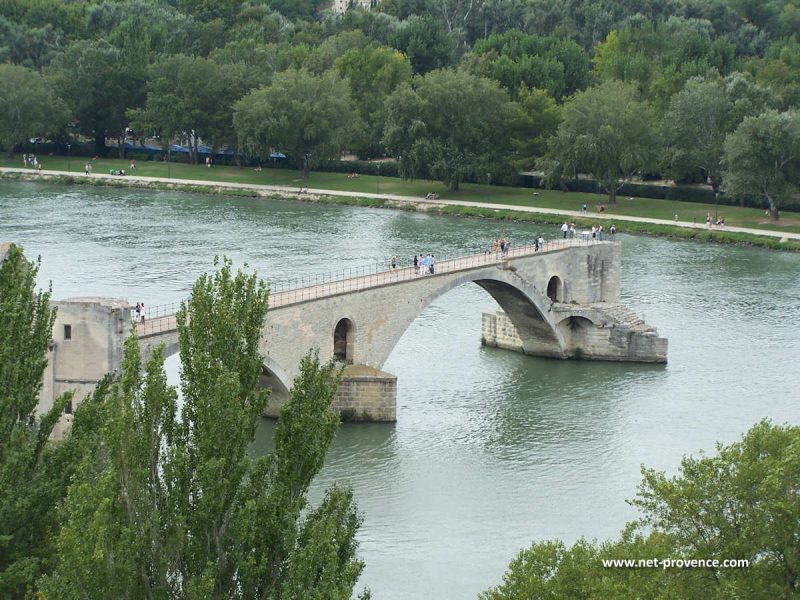
Like most children with a French heritage, I grew up with my parents singing “Sur le Pont D’Avignon”. It is de rigeur for any francophone to know it. So, for those of you not of my cultural background, I offer up the sheet music and lyrics. If you want a translation, you’ll need to look elsewhere.

These days the old Papal palace is open up to the public and it does not always attract the best element. Several Roma Gypsies were making their rounds trying to scam tourists with fake petitions and causes. Donate for such and such cause, sign your name here, etc. It’s just a more sophisticated form of begging that preys on the innocence of well meaning folk. Since I’m neither innocent, nor well meaning, I had nothing but contempt for them. Moreover, they are idiotic thieves, they used a piece of cardboard to hold their fake donation sheets. Low budget all the way. Eventually some police officers showed up and in the blink of an eye the Romas vanished as though there were a transporter that whisked them away to the Spaceship Parasite.
On a more positive note, there was a very talented busker, namely a clever one man band try to earn an honest living. I found him talented and entertaining, so I gave him a few well deserved Euros.

Freed from any tour group or schedules, Elaine and I had plenty of time to explore the old Palace and take photos. All in all a terrific day.
![120912-10-53-PENTAX K-5-smc PENTAX-DA- 16-50mm F2.8 ED AL [IF] SDM](http://www.robfaucher.com/wp-content/uploads/2012/10/120912-10-53-PENTAX-K-5-smc-PENTAX-DA-16-50mm-F2.8-ED-AL-IF-SDM-800x529.jpg)
![120912-11-11-PENTAX K-5-smc PENTAX-DA- 16-50mm F2.8 ED AL [IF] SDM-2 Papal Seal](http://www.robfaucher.com/wp-content/uploads/2012/10/120912-11-11-PENTAX-K-5-smc-PENTAX-DA-16-50mm-F2.8-ED-AL-IF-SDM-2-397x600.jpg)





